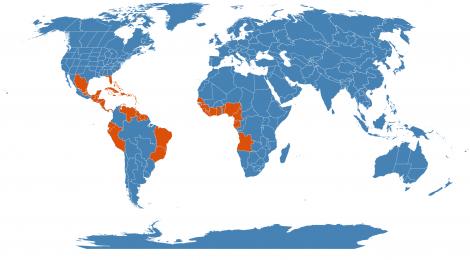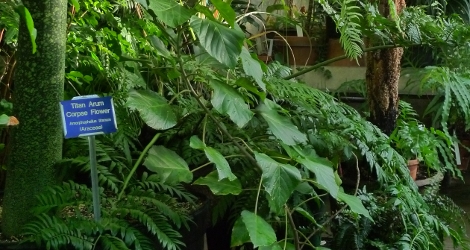Accession Data:
Laguncularia racemosa (L.) Gaertn. f.
- Common Name: White Mangrove
- Family: Combretaceae R. Br.
- Country of Origin: Both coasts of tropical America

- Habitat: coastal areas of bays, lagoons, and tidal creeks
- Description: Evergreen tree to 12 m tall and 30 cm diameter, with rounded or irregular spreading crown. Bark gray-brown, becoming rough and fissured; inner bark light brown. Pneumatophores often present. Leaves Opposite, elliptical, 4-10 cm long, 2.5-5 cm wide, rounded at both ends, entire, glabrous, leathery, slightly fleshy, without visible veins. Petiole 10–13 mm long, stout, reddish, with 2 raised gland-dots near blade. Panicles at ends and sides of twigs, mostly branched and spreading, 3-10 cm long. Flowers mostly bisexual ca 5 mm long, bell-shaped, whitish. Petals, 5, rounded, whitish, 1 mm long, and stamens, 10. Pistil with inferior 1-celled ovary with 2 ovules, slender style, and tiny 2-lobed stigma. Drupes several, stalkless, obovoid, 12-20 mm long, flattened, ridged, gray-green with velvety hairs when immature, turning brownish, Seed 1, large, sometimes viviparous. 1
- USDA Zone: 10b-11
Accession Data:
- Accession # 200400003
- Source: Debbie Black - UIUC
- Recorded Vouchers:
- Voucher CONN00225898 at George Safford Torrey Herbarium (CONN). Specimen collected 9 FEB 2018.
- Accession Date: 01-23-2004
- Bench: 0 - unassigned location
- Currently: active - marginal (no foliage)
- Qty: 0 confirmed on 01-04-2025
- Restrictions:
Classification:
- Division: Magnoliophyta
- Class: Magnoliopsida
- SubClass: rosids
- Order: Myrtales
- SubOrder:
- Family: Combretaceae
- SubFamily: Combretoideae
- Tribe: Laguncularieae
- SubTribe:
Flowering Data:
This accession has been observed in bloom on:| Year | Jan | Feb | Mar | Apr | May | Jun | Jul | Aug | Sep | Oct | Nov | Dec | ||||||||||||||||||||||||||||||||||||||||
|---|---|---|---|---|---|---|---|---|---|---|---|---|---|---|---|---|---|---|---|---|---|---|---|---|---|---|---|---|---|---|---|---|---|---|---|---|---|---|---|---|---|---|---|---|---|---|---|---|---|---|---|---|
| 2025 | ||||||||||||||||||||||||||||||||||||||||||||||||||||
| 2024 | ||||||||||||||||||||||||||||||||||||||||||||||||||||
| 2023 | ||||||||||||||||||||||||||||||||||||||||||||||||||||
| 2022 | ||||||||||||||||||||||||||||||||||||||||||||||||||||
| 2021 | ||||||||||||||||||||||||||||||||||||||||||||||||||||
| 2020 | ||||||||||||||||||||||||||||||||||||||||||||||||||||
| 2019 | ||||||||||||||||||||||||||||||||||||||||||||||||||||
| 2018 | ||||||||||||||||||||||||||||||||||||||||||||||||||||
| 2017 | ||||||||||||||||||||||||||||||||||||||||||||||||||||
| 2016 | ||||||||||||||||||||||||||||||||||||||||||||||||||||
| 2015 | ||||||||||||||||||||||||||||||||||||||||||||||||||||
| 2014 | ||||||||||||||||||||||||||||||||||||||||||||||||||||
| 2013 | ||||||||||||||||||||||||||||||||||||||||||||||||||||
| 2012 | ||||||||||||||||||||||||||||||||||||||||||||||||||||
| 2011 | ||||||||||||||||||||||||||||||||||||||||||||||||||||
| 2010 | ||||||||||||||||||||||||||||||||||||||||||||||||||||
| 2009 | ||||||||||||||||||||||||||||||||||||||||||||||||||||
| 2008 | ||||||||||||||||||||||||||||||||||||||||||||||||||||
| 2007 | ||||||||||||||||||||||||||||||||||||||||||||||||||||
| 2006 | ||||||||||||||||||||||||||||||||||||||||||||||||||||
References (internal):
- Aquatic Plants
- Benthophyte
- Plants with Extrafloral Nectaries
- EEB 3203 - Developmental Plant Morphology
- Plants with Vouchers deposited in CONN
- EEB Greenhouse Holdings native to: Benin / Ghana / Guinea-Bissau / Guinea / Ivory Coast / Liberia / Nigeria / Senegal / Sierra Leone / Cameroon / Equatorial Guinea / Gabon / Angola / Florida / Mexico Central / Mexico Northeast / Mexico Gulf / Mexico Southeast / Belize / Costa Rica / El Salvador / Guatemala / Honduras / Nicaragua / Panama / Aruba / Bahamas / Cayman Is. / Cuba / Dominican Republic / Haiti / Jamaica / Leeward Is. / Netherlands Antilles / Puerto Rico / Windward Is. / French Guiana / Guyana / Suriname / Venezuela / Ecuador / Peru / Brazil Northeast / Brazil Southeast
References (external):
- Laguncularia racemosa at NewCrops @ Purdue. Last accessed on Wednesday, September 14, 2016.
- The Plant List (2013). Version 1.1. Last accessed on Wednesday, September 14, 2016.
- Laguncularia racemosa at ARS-GRIN. Last accessed on Wednesday, September 14, 2016.
- Laguncularia racemosa at GBIF. Last accessed on Wednesday, September 14, 2016.
data regenerated on Sat, 04 Jan 2025 11:12:02 -0500 [bcm v4.0]
Images:

Additional images for this accession:
Click on thumbnails to enlargeCurrent Accessions in the Combretaceae
Subfamily Combretoideae
Tribe Combreteae
- Combretinae: Combretum molle


Subfamily Combretoideae
Tribe Laguncularieae
W/C = Wild Collected
 = indicates flowering in past 14 days
= indicates flowering in past 14 days
 = images available for this accession
= images available for this accession
 = map available for this accession
= map available for this accession
 = accession added within past 90 days
= accession added within past 90 days